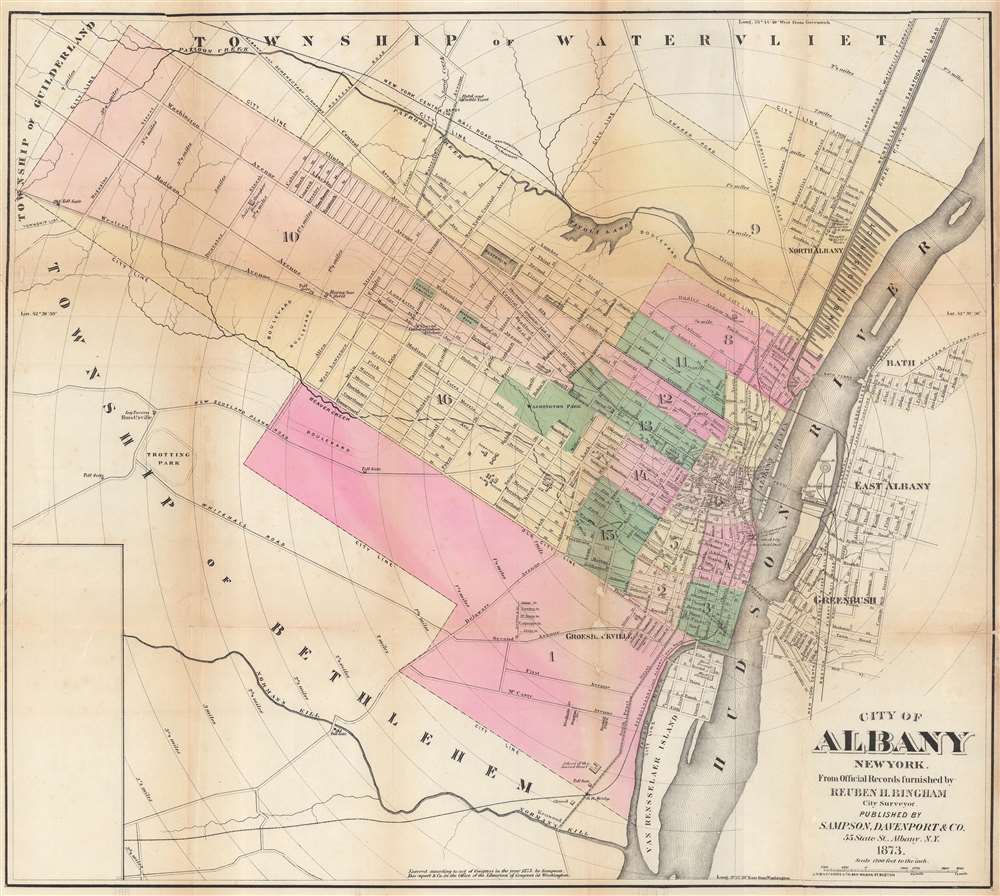1873 Sampson and Davenport City Plan or Map of Albany, New York
Albany-sampsondavenport-1873
Title
1873 (dated) 21.25 x 24 in (53.975 x 60.96 cm) 1 : 14400
Description
A Transportation Hub
In the second half of the 19th century, Albany became a major transportation hub. Four major railroad lines converged in Albany: The New York Central Railroad, the Susquehanna and Albany Railroad, the Boston and Albany Railroad, and the Rensselaer and Saratoga Railroad. Additionally, the Erie Canal's eastern terminus was in Albany, with vessels exiting into the Hudson River, and providing the city with unfettered access to western New York's rich raw materials. During the same period, these factored led to Albany's development as a major industrial and milling center. The city was home to the nation's largest lumber market (labeled here along the Hudson River as 'lumber district'), the second most largest publishing industry in the United States, major iron foundries, and numerous banks. Several buildings are illustrated and labeled, including the 'New Capitol', City Happ, and the Penitentiary. Streets are labeled throughout, and concentric circles marking half-mile intervals emanate from the center of town.Publication History and Census
This map was published by 'Sampson, Davenport and Company' 'from official records furnished by Reuben H. Bingham' and printed by J.H. Bufford in 1873. Four examples are cataloged in OCLC: New York Public Library, the Library of Congress, the State Library of Massachusetts, and the Wisconsin Historical Society.CartographerS
George Sampson (fl. c. 1858 - c. 1930) was a Boston based publisher and printer active in the second half of the 19th century. Sampson initially partnered with George Adams, acquiring a half-share in the Boston Directory or Boston Almanac, and subsequently publishing as Adams, Sampson, and Company. Adams shares were eventually acquired by O.H. Davenport in 1865, when the company named changed to Sampson and Davenport. Working with Davenport, Sampson, expanded the scope of the Boston Directory to incorporate other towns and regions, producing the Massachusetts Register, the New York State Business Directory, the New England Gazetteer, the Roxbury Directory, and the Providence Almanac, among others, as well as various individual maps and guides. Davenport's shares were acquired by A. Murdoch in 1884. As Sampson and Murdoch, the firm expanded again, producing a catalog of over 120 city directories by 1925. The business passed into the hands for R. L. Polk and Company around 1930 and continued to publish directories until about 1980. More by this mapmaker...
John Henry Bufford (July 27, 1810 - October 8, 1870) was a Boston based lithographer and printer. Bufford was born in Portsmouth, New Hampshire. He apprenticed as an artist and lithographer at Pendleton Lithography (1825 - 1836) of Boston. In 1835 he relocated to New York where he took independent commissions from George Endicott and Nathaniel Currier, among others. Returning to his hometown of Boston in 1839, he took a position of chief artist with the firm of Benjamin W. Thayer, heir to Pendleton Lithography. He probably married Thayer's sister, Anna Melora Tufts Thayer (1808-1878). Bufford has been highly criticized as an engraver, with one historian, David Tatham, stating he had 'a mediocre sort of craftsmanship at best' and 'no very special skills as an original artist.' We, however, find no justification for this harsh criticism. Instead Bufford gravitated toward business and management. By 1844 Thayer's shop was renamed J. H. Bufford and Company. The firm specialized in decorative sheet music, panoramic views, illustrations for books, retractions of paintings, and commercial printing. Bufford is credited with being one of the first employers and mentors of the important artist and engraver Winslow Homer. Bufford died in 1870, passing on the business to his sons Frank G. Bufford and John Henry Bufford Jr. These young men, operating under the imprint of 'J.H. Bufford's Sons, Manufacturing Publishers of Novelties in Fine Arts', expanded the firm with offices in New York and Chicago. A possibly related lithographic printing firm named Bufford Chandler was incorporated in Boston in 1893. It later relocated to Concord, New Hampshire but closed in 1925 when its state business charter was repealed. Learn More...

